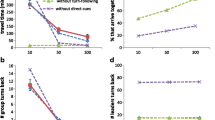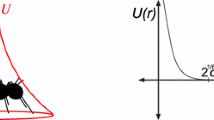Abstract
Soil-dwelling social insects build complex nests. Nest excavation is performed by multiple animals simultaneously and is governed by local interactions of the workers with other nest-mates and their surroundings. To investigate collective confined excavation challenges, we built groups of robotic excavators capable of performing hours of autonomous tunnel excavation in a model cohesive granular medium. Excavator behavior was governed by a simple set of rules triggered by interactions with the surrounding environment and other robots. The rate of tunnel growth and energetic costs of excavation were measured for groups of different numbers operating in wide and narrow tunnels. To extend the results to systems with large numbers of robots, we developed a cellular automata model. Experiments and simulations showed that in sufficiently wide tunnels an increase in the size of the excavating group increased the excavation rates without a significant increase in the energy consumption per robot. A decrease in the tunnel width resulted in a decrease in the excavation rates and increase in the energetic costs of excavation. We attribute this effect to the emergence of multiple time-consuming interactions (clogs) among excavating robots in the confined spaces. Although in all situations clogs were resolvable, clog resolution took longer in the systems with larger number of robots and narrower tunnels. We expect that our robotic system can be used to investigate the behavior of social insects in confined spaces as well as inspire more sophisticated search-and-rescue robotics.









Similar content being viewed by others
References
Wilson EO (1990) Success and dominance in ecosystems: the case of social insects. Ecology Institute, Federal Republic of Germany, Oldendorf/Luhe
Wilson EO (1971) The insect societies. Harvard University Press, Cambridge
Turner JS (2000) The extended organism: the physiology of animal-built structures. Harvard University Press, Cambridge
Hölldobler B, Wilson EO, Nelson MC (2009) The superorganism : the beauty, elegance, and strangeness of insect societies. W.W. Norton, New York
Monaenkova D, Gravish N, Rodriguez G, Kutner R, Goodisman MAD, Goldman DI (2015) Behavioral and mechanical determinants of collective subsurface nest excavation. J Exp Biol 218:1295–1305. doi:10.1242/jeb.113795
Theraulaz G, Bonabeau E (1999) A brief history of stigmergy. Artif life 5(2):97–116. doi:10.1162/106454699568700
Keller L, Chapuisat M (1999) Cooperation among selfish individuals in insect societies. Bioscience 49(11):899–909. doi:10.2307/1313649
Gravish N, Monaenkova D, Goodisman MAD, Goldman DI (2013) Climbing, falling, and clogging during ant locomotion in confined environments. Proc Natl Acad Sciences USA 110(24):9746–9751. doi:10.1073/pnas.1302428110
Tschinkel WR (2006) The fire ants. Belknap Press of Harvard University Press, Cambridge
Cao TT, Dornhaus A (2008) Ants under crowded conditions consume more energy. Biol Lett 4(6):613–615. doi:10.1098/rsbl.2008.0381
Gravish N, Gold G, Zangwill A, Goodisman MA, Goldman DI (2015) Glass-like dynamics in confined and congested ant traffic. Soft Matter 11(33):6552–6561. doi:10.1039/c5sm00693g
Aguilar J, Zhang T, Qian F, Kingsbury M, Benjamin M, Mazouchova N, Li C, Maladen R, Gong C, Travers M, Hatton RL, Choset H, Umbanhowar PB, Goldman DI (2016) A review on locomotion robophysics: the study of movement at the intersection of robotics, soft matter and dynamical systems. Reports on Progress in Physics (in press)
Acknowledgments
The authors would like to acknowledge support of National Science Foundation Grants Number PoLS #0957659, #PHY-1410971 and #PHY-1205878.
Author information
Authors and Affiliations
Corresponding author
About this article
Cite this article
Linevich, V., Monaenkova, D. & Goldman, D.I. Robophysical study of excavation in confined environments. Artif Life Robotics 21, 460–465 (2016). https://doi.org/10.1007/s10015-016-0317-2
Received:
Accepted:
Published:
Issue Date:
DOI: https://doi.org/10.1007/s10015-016-0317-2




